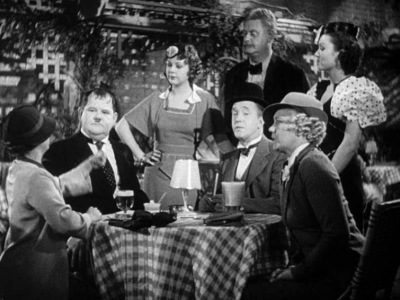
Twelve years later, Arline (now played by Julie Bishop) has blossomed into a beautiful gypsy girl but is put in harm’s way when her community is persecuted as undesirables by the Count and his menacing henchman, Captain Finn (James Finlayson). Soon Devilshoof and Ollie’s wife run off with Stan’s stolen jewels, leaving the boys to raise the little girl on their own. When Devilshoof is punished by Count Arnheim’s soldiers for an offense, he takes revenge by abducting Arline (Darla Hood of Our Gang fame), the only child of the Count. Despite some tailoring to fit the comic duo’s unique talents, the movie version of The Bohemian Girl (1936) was partially faithful to the original operetta with Stan Laurel cast in the atypical role of a gifted thief and Oliver Hardy as his friend and cuckolded husband of a shrew (Mae Busch) who flirts openly with her lover, Devilshoof (Antonio Moreno). As a result, the film rights to Michael Balfe’s 1843 musical, The Bohemian Girl, were secured and the boys found themselves playing gypsies in 17th century Bohemia. Laurel and Hardy in The Bohemian Girl (1936) image courtesy of Īfter the financial success of Fra Diavolo (1933, aka The Devil’s Brother) and Babes in Toyland (1934, aka March of the Wooden Soldiers), producer Hal Roach was temporarily convinced that Laurel and Hardy fared best in screen adaptations of popular operettas.

For those who fall between both camps and have never seen The Bohemian Girl, this is your homework.

And L&H devotees find the music as insufferable and annoying as those musical passages in the MGM Marx Brothers comedies where you just want the boys to get on with their business. Unfortunately, most operetta aficionados dislike it because the music is secondary to the narrative and is not given a showcase deserving of the libretto.

What stood out were the hilarious sight/audio gags such as Ollie’s bafflement at his partner’s slight-of-hand tricks, the horse scrubbing sequence, and Stan’s switch from high soprano to basso while singing those have a resonate power to make you laugh in the worst of times. Even though the 1936 Laurel and Hardy feature The Bohemian Girl is not ranked among their best by the duo’s fervent fans or film historians, I have a fondness for it because I saw it at an early age before I was even aware of their silent films or the movies which would later become all-time favorites – Way Out West (1937), A Chump at Oxford (1940) and Sons of the Desert (1933).


 0 kommentar(er)
0 kommentar(er)
